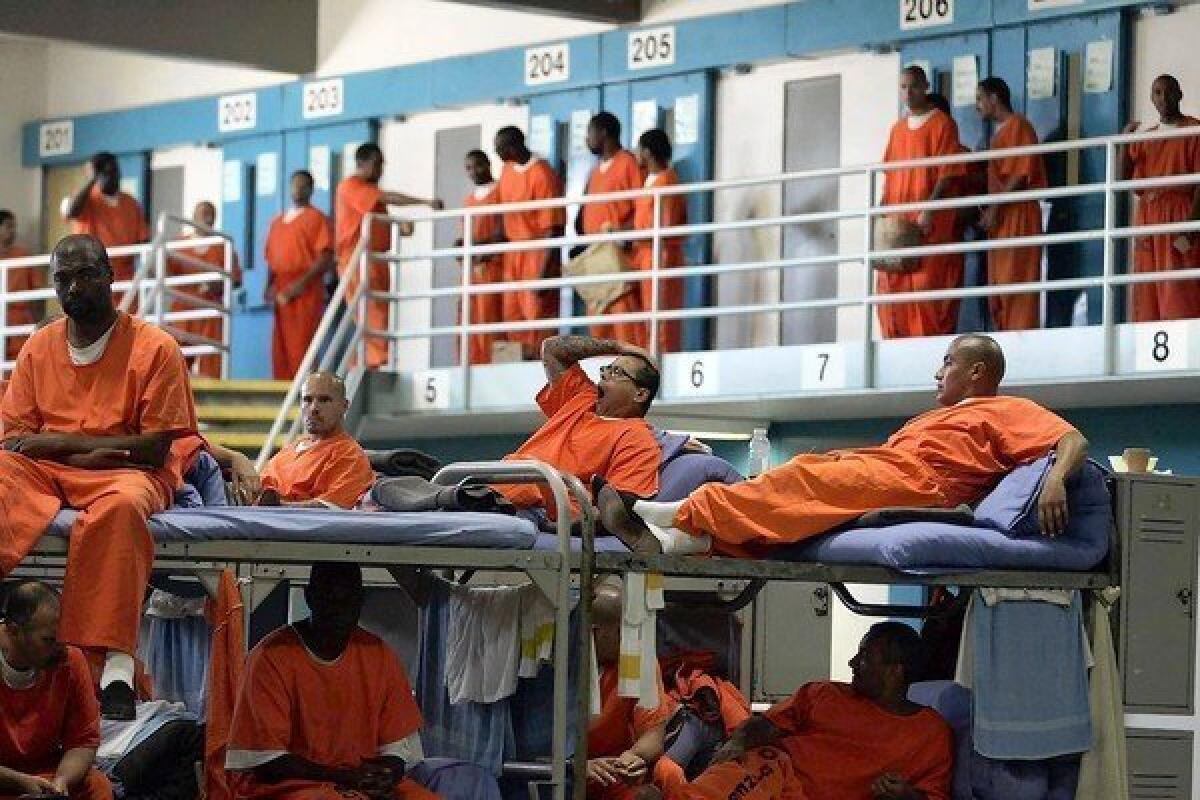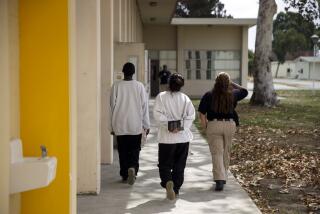California unlikely to meet prison crowding reduction requirement

- Share via
SACRAMENTO — California’s progress in relieving its teeming prisons has slowed so much that it probably won’t comply with a court-ordered population reduction, and judges have raised the prospect of letting some inmates out early.
Three federal jurists have given the state until Friday to come up with a schedule for identifying prisoners “unlikely to reoffend or who might otherwise be candidates for early release” and to detail other ways to hasten the emptying of double-bunked cells.
In the interim, the judges have ordered California to “take all steps necessary” to meet their existing deadline for population cuts.
A recent flurry of legal motions that provoked the judges’ Aug. 3 order shines the first light on shortcomings in California’s plan for fixing its prison system — one so overburdened, with healthcare so poor, that the U.S. Supreme Courtsaid incarceration there was tantamount to “cruel and unusual punishment.”
In May 2011, the high court gave California two years to comply with the three judges’ determination that prisons should not be overcrowded by more than 137.5%. State officials concede they are unlikely to reach that target by the June 2013 deadline and have told the judges they intend to ask for a new cap of 145%.
That would mean about 118,000 prisoners, which is about 6,000 more than the court wants, in quarters built for 81,500.
The officials say they can comply with the spirit of the order — improved medical care and humane living conditions — if not the letter.
“Reducing the inmate population is not the goal of the court,” said corrections agency spokesman Bill Sessa. “It is a means to an end, which is providing better healthcare that was compromised by overcrowding.”
He said the goal of improved healthcare would be achieved next year, when the state opens a new 1,700-bed prison hospital in Stockton to house critically ill and long-term-care patients, which will also further reduce crowding.
Since October, Gov. Jerry Brown’s realignment program has diverted tens of thousands of low-level felons to county jails and probation programs rather than put them in state lockups. A Times analysis of prison population reports and projections for the last year shows the number of inmates fell faster than analysts predicted but then leveled off.
In October, the prison population was shrinking by more than 4,000 inmates a month. That has now shriveled to fewer than 1,000 and is expected to fall further as many of the remaining low-level offenders leave the system.
Drew Soderborg, an economist and prisons expert in California’s independent legislative analyst’s office, issued a report in February that questioned whether realignment would produce the promised results.
Projecting the impact of such a novel project is difficult, Soderborg said, but “I don’t think it was ever the case” that the state would meet the court’s targets.
The biggest gains from realignment were within three months of its launch, according to the analysis. The arrival of new convicts at state prisons dropped 30% by December and has remained largely flat since.
The number of offenders returning to prison on parole violations also fell quickly, from nearly 13,000 three months before realignment to 15 from January to March of this year.
“I think they never intended to get to the court-ordered reduction,” said Don Specter at Prison Law Office, lead lawyer for the legal team representing prisoners as plaintiffs in the litigation.
At the state’s first suggestion in a budget document last April that it might not meet the court’s targets, the plaintiffs asked the court to force the Brown administration to either prove it could comply or come up with new steps for removing more prisoners, including early releases based on good behavior.
The state balked but told the court it would be unlikely to meet its deadline and would seek dispensation early next year, when officials expect to begin missing the population benchmarks. That led to the judges’ Aug. 3 order.
California’s assertion that it can provide adequate care at 145% of prison capacity has been litigated and rejected for years. In its recent order, the three-judge panel said the state already is exceeding its own prison population estimates, calling into question whether it could even meet a higher limit.
Inmate advocates object to raising the cap, saying that would remove motivation for officials to make other changes in the criminal justice system that lead to overcrowding.
“This is the push the state has needed to do something different,” said Emily Harris, director of Californians United for a Responsible Budget, a consortium of inmate advocacy groups.
More to Read
Sign up for Essential California
The most important California stories and recommendations in your inbox every morning.
You may occasionally receive promotional content from the Los Angeles Times.











